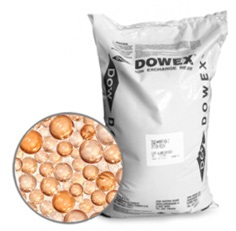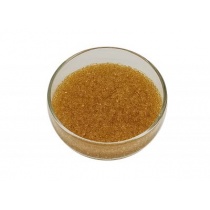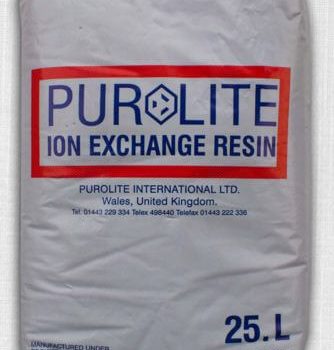ION EXCHANGE RESINS
Ion exchange resins are small balls of gel-like texture, often yellow in color.
The hardness of water is determined by the presence of magnesium and calcium cations - hardness salts.
Water softeners based on ion exchange resins work as follows:
Passing through the resin layer, Ca2+ and Mg2+ ions in the hard source water are replaced by Na ions. At the outlet of the softener, the water becomes soft because the hardness salts (Ca2+ and Mg2+) remain on the surface of the ion exchange resin. During use, ion exchange resins become saturated with calcium and magnesium ions, which reduces their ion exchange capacity.
In order to restore the ion exchange capacity of the resin, regeneration is necessary by passing a saturated NaCl salt solution through the ion exchange resin bed. During regeneration, the resin gives up the accumulated calcium and magnesium salts in the solution and takes up the sodium salts from the solution, thus returning to its original working state.
Ion exchange resins are common in water treatment systems, typically used in a variety of applications including water softening, demineralization, deionization, and removal of certain contaminants.
Purpose and need for ion exchange resins:
- Water Softening. One of the main applications of ion exchange resin is water softening. Hard water contains large amounts of calcium and magnesium ions, which can lead to the formation of scale in pipes and appliances, which significantly affects the duration and quality of operation. Ion exchange resins can replace these calcium and magnesium ions with sodium ions, effectively "softening" the water and preventing scale formation.
- Demineralization and deionization. In industrial and laboratory settings, water often requires an additional degree of purification. Ion exchange resins can be used to demineralize and deionize water by removing different types of ions, including cations (positively charged ions) and anions (negatively charged ions), resulting in ultrapure water.
- Pollutant Removal: ion exchange resins can also be tailored to remove specific pollutants such as heavy metals, nitrates, sulfates, and other unwanted ions. The resin's affinity for specific ions allows it to selectively bind and remove these pollutants from water.
Selection of ion exchange resins:
There are several factors to consider when selecting the right ion exchange resin for your specific application:
- Ion Type: Determine the specific ions to be removed or replaced. For example, cation exchange resins are used to remove positively charged ions, and anion exchange resins are used to remove negatively charged ions.
- Water flow rate and volume. Consider the flow rate and volume of water to be purified. Different types of resins have different capacities and flow rates. Some resins can handle higher flow rates but may have lower ion exchange capacity, while others are better suited for lower flow rates but with higher ion exchange capacity.
- Regeneration Process: Ion exchange resins have a finite capacity before they become saturated with ions. Regeneration involves removing trapped ions and restoring the capacity of the resin. Understanding the regeneration requirements and associated costs is critical.
- Operating Conditions: Consider operating conditions such as temperature, pH, and pressure. Some resins may perform better under certain conditions.
- Cost and sustainability: Consider the initial cost of the resin as well as the ongoing costs associated with resin replacement, regenerating chemicals, and disposal. In addition, consider the environmental impact and sustainability of the selected resin.
In summary, ion exchange resins play a crucial role in water treatment by removing ions from water to achieve the desired quality. Selection of the appropriate resin depends on treatment objectives, water consumption, regeneration process, chemical compatibility, operating conditions, and cost considerations. Consultation with Aquarum experts can help ensure the best choice for your specific application.

Untreated tap water contains mechanical impurities, metals, bacteria, pesticides, chemicals in varying amounts that accumulate in the body and can cause various diseases.

Water treatment helps get rid of the unpleasant taste and odor that appear as a result of an increase in the concentration of inorganic and organic substances in the composition of such water.

Lithuanian water leads to the accumulation of scale on the heating surfaces of electrical appliances, consequently reducing their thermal conductivity. This accelerates appliance failure and increases energy costs.

It is known that the consumption of clean water is extremely important for maintaining health. That is why purified water is necessary for a person to protect himself from many diseases and to continue an active life without doctors and pills.
own enterprise
customized solutions
operational experience
and installation











